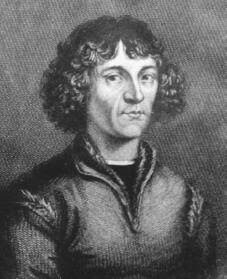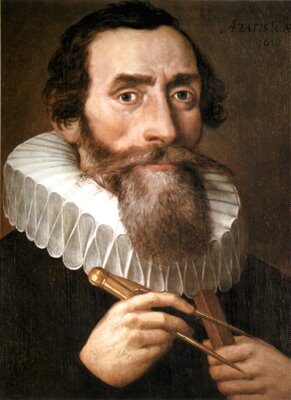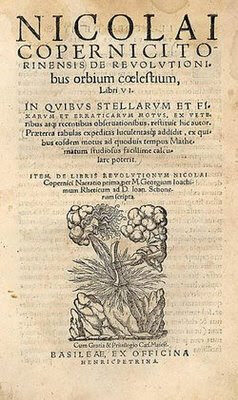Having mentioned Mano Singham’s Physics Today article “The Copernican myths” in a few of my posts, I thought to reproduce it here.1 Following is the text of the article:
Atheism and scienceThe real story of how the scientific and religious establishment greeted the Copernican revolution is quite different from the folklore. And it’s a lot more interesting.
Atheism and science
Perhaps the most famous of all scientific revolutions is the one associated with Nicolaus Copernicus (1473-1543). The popular version of the story goes as follows:
The ancient Greeks, although they were great philosophers and good at mapping the motions of stars and planets, tended to create models of the universe that were more influenced by philosophical, aesthetic, and religious considerations than by observation and experiment. The idea that Earth was the stationary center of the universe, and that the stars and planets were embedded in spheres that rotated around Earth, appealed to them because the circle and the sphere were the most perfect geometric shapes. In the Christian era, the model also pleased religious people because it gave pride of place to human beings – God’s special creation. The prestige of Greek philosophers like Aristotle was so great, and commitment to religious doctrine so strong, that many scholars stubbornly tried to retain Ptolemaic astronomy even though increasingly complicated epicycles had to be added to make the system work even moderately well. So when Copernicus came along with the correct heliocentric system, his ideas were fiercely opposed by the Roman Catholic Church because they displaced Earth from the center, and that was seen as both a demotion for human beings and contrary to the teachings of Aristotle. Therefore the Inquisition persecuted, tortured, and even killed those who advocated Copernican ideas. Because of the church’s adherence to philosophical and religious dogma, scientific progress was held back for a millennium. It was the later work of Tydto Brahe (1546-1601), Johannes Kepler (1571-1630), Galileo Galilei (1564-1642), and Isaac Newton (1642-1727) that finally led to the acceptance of heliocentrism.
Atheism and science
Variations on this breezy version of the Copernicus story are common in science textbooks.2 How much of the story is true? Apart from the final sentence, not much. But it’s a good illustration of how scientific folklore can replace actual history.
Let us start with the myth that the Copernican model was opposed because it was a blow to human pride, dethroning Earth from its privileged position as the center of the universe. Dennis Danielson, in his fine article on the subject3 shows how widespread that view is by quoting the eminent geneticist Theodosius Dobzhansky. With Copernicus, Dobzhansky contends, “Earth was dethroned from its presumed centrality and preeminence.” Carl Sagan described Copernicanism as the first of a series of “Great Demotions. . .delivered to human pride.” Astronomer Martin Rees has written, “It is over 400 years since Copernicus dethroned the Earth from the privileged position that Ptolemy’s cosmology accorded it.” And Sigmund Freud remarked that Copernicus provoked outrage by his slight against humankind’s “naa&#af;ve self-love.”

Nicolaus Copernicus
Atheism and science
The squalid basement
Danielson, however, points out that in the early 16th century, the center of the universe was not considered a desirable place to be. “In most medieval interpretations of Aristotelian and Ptolemaic cosmology, Earth’s position at the center of the universe was taken as evidence not of its importance but. . . its grossness.” In fact, ancient and medieval Arabic, Jewish, and Christian scholars believed that the center was the worst part of the universe, a kind of squalid basement where all the muck collected. One medieval writer described Earth’s location as “the excrementary and filthy parts of the lower world.” We humans, another asserted, are “lodged here in the dirt and filth of the world, nailed and rivetted to the worst and deadest part of the universe, in the lowest story of the house, and most remote from the heavenly arch.” In 1615 Cardinal Robert Bellarmine, a prominent persecutor of Galileo, said that “the Earth is very far from heaven and sits motionless at the center of the world.”4
In Dante Alighieri’s The Divine Comedy, hell itself is placed in Earth’s inner most core. Dante also speaks of hell in ways consistent with Aristotelian dynamics – not full of flames, which would be displaced skyward by the heavier Earth, but as frozen and immobile.By contrast, heaven was up, and the further up you went, away from the center, the better it was. So Copernicus, by putting the Sun at the center and Earth in orbit around it, was really giving its inhabitants a promotion by taking them closer to the heavens.
Atheism and science
When and why did the history become distorted? Danielson doesn’t pinpoint when the erroneous view gained supremacy, But he says that from 1650 onward one can find some writers making this revisionist claim. By the late 18th century it had taken hold completely. Johann Wolfgang von Goethe (1749-1832), for example, wrote: “Perhaps no discovery or opinion ever produced a greater effect on the human spirit than did the teaching of Copernicus. No sooner was the Earth recognized as being round and self-contained, than it was obliged to relinquish the colossal privilege of being the center of the world.” Here Goethe managed to propagate another major distortion: the notion that before Copernicus (and Columbus) it was not known that Earth was a sphere.5
Aristotle’s cosmology
Even Aristotle did not believe Earth to be the center of the universe. He thought it rather to be at the center. This fine distinction was not driven by religious dogma or human self-importance but by physics arguments: In Aristotle’s cosmology the universe was finite and the heavens existed beyond its outermost sphere. The universe had a center-defined as the center of the large outer sphere in which the stars were embedded – and matter was drawn to that center. In that cosmology, “up” and “down” were well defined. “Down” was toward the center of the universe and “up” was away from it, toward the sphere containing the stars.
The elements were earth, air, water, and fire, and each element had its natural affinity for a location in the universe.As could be seen from the fact that rocks fell to the ground, earth, being heavy, was drawn to the center. Flames leaping upwards showed that fire, being lif’t, was drawn towards the heavens. The model explained many things, such as why objects fell to the ground when released from any point and why Earth’s surface was spherical. It also explained why Earth was motionless at the center. For it to move there would have to be something that took it away from the center. And no such agent was in evidence.
Atheism and science
In his book The Copernican Revolution, historian Thomas Kuhr1 pointed out that Aristotle was clearly saying that Earth was at the center of the universe not because it was especially important but simply because it was massive: “It so happens that the Earth and the Universe have the same center, for the heavenly bodies do move towards the center of the Earth, yet only incidentally; because it has its center at the center of the universe.”6

Johannes Kepler
Atheism and science
Problems with heliocentricity
Copernicus’s heliocentric model, on the other hand, created all manner of difficulties. It required Earth to be in motion, but it did not say what caused it to move away from the center. If Earth was not stationary at the center but was midway in the sequence of planetary orbits around the Sun, how could you define “up” and “down”? Why would objects fall “down” if Earth were not at the center of the universe? How could objects thrown upward fall back to the same point if Earth was not at rest? Earth was still believed to be the most massive object in the universe. So if it was riot drawn to a fixed point at the center, did that mean that the universe had no center? Could that mean that the universe was infinite?
Kuhn argues that there were thus excellent reasons for rejecting the upstart Copernicus and retaining Aristotelian cosmology and its elaboration in Ptolemaic astronomy. Accepting Copernicus would not simply replace one astronomical model with another. It also meant that a whole class of physics problems that had been considered solved were now suddenly unsolved. Therefore much of the initial resistance came from within the physics and astronomy communities rather than from the church.
Atheism and science
In fact, awareness of Copernicus’s work was at first largely restricted to the community of astronomers. Only they were interested in improving the calculation of planetary motions. Copernicus was widely respected as one of Europe’s leading astronomers, and reports about his work, including his heliocentric hypothesis, had been circulating since 1515. So when his De Revolutionibus Orbium Coelestium (On the Revolutions of the Celestial Spheres) was published 28 years later, it was hardly a surprise to other astronomers. They accepted it as the most comprehensive account of celestial motions since Ptolemy.
Atheism and science
But most astronomers also felt that the Ptolemaic system, although complicated, could ultimately be made to work. So while they hailed Copernicus’s work and used his tables and methods, they were skeptical of his central idea of a moving Earth. They dismissed it as an ad hoc trick (much as Max Planck’s quantum hypothesis was initially viewed centuries later) that turned out to be a useful tool for calculations. The idea that the motion described by some artificial model was a convenient fiction was not unprecedented. Ptolemy himself had said that not all of his epicycles had to be considered physically real. Some were to be thought of as merely mathematical devices that gave sound results.

Galileo Galilei
Atheism and science
Initially, however, the Copernican system did not give better numerical results than the Ptolemaic. Part of the problem was that some of the existing astronomical observations were simply erroneous, a problem that plagued Ptolemaic and Copernican astronomy alike. Although better observations soon eliminated some of those problems, other problems remained obdurate for a long time. Furthermore, at the level of accuracy available to Copernicus, the introduction of ellipses in place of circular orbits would not have helped. What Copernicus needed to do, as historian Owen Gingerich puts it, was to “treat Earth and Mercury the same way as the other planets.”
Kuhn says of Copernicus: “His full system was little if any less cumbersome than Ptolemy’s had been. Both employed over thirty circles; there was little to choose between them in economy. Nor could the two systems be distinguished by their accuracy. When Copernicus had finished adding circles, his cumbersome sun-centered system gave results as accurate as Ptolemy’s, but did not give more accurate results. Copernicus had failed to solve the problem of the planets.”7
Atheism and science
Advantages
The Copernican model did have some aesthetic and qualitative advantages. It provided a more natural qualitative explanation for the zigzag motion of planets like Mars as observed from Earth, and it answered some important questions about the ordering of the planets. That’s why heliocentrism was eventually accepted. As Kuhn puts it, “De Revolutionibus did convince a few of Copernicus’ successors that sun-centered astronomy held the key to the problem of the planets, and these men finally provided the simple and accurate solution that Copernicus had sought.” [see footnote 6]
Atheism and science
That’s an important point about scientific revolutions. At the start, the new theory rarely gives convincingly better results than its predecessor. What usually happens is that it has some appeal, often aesthetic, that attracts others to work within the new model. And if, over time, the new model proves fruitful in resolving many puzzles, it gains adherents. [see footnote 7]
The success of the Copernican model was aided by the work of the Danish astronomer Tycho Brahe, who died a few years before the invention of the telescope. Tycho is considered the greatest of the naked-eye observers. His wide ranging and accurate observations had an enormous impact.
Atheism and science
Although Tycho’s pivotal role is recognized, what is less well known is that he, like most astronomers at the time, rejected Copernicus’s ideas of a movin8 Earth. It created more problems, he thought, than it solved. But despite Tycho’s opposition, his observations provided two major benefits for the heliocentric model: They got rid of some erroneous old data that had plagued all the earlier models and thus helped to remove some of the anomalies that the Copernican system couldn’t explain. More important, the precision of Tycho’s data provided puzzles that enabled Kepler, a convert to Copernicanism, to come up with the key idea that the motions of the planets were not circular – as Ptolemy; Copernicus, and Tycho had all assumed – but elliptical.
In the folklore that surrounds Copernicus, the introduction of elliptical orbits is rightly recognized as a crucial development that led to ultimate acceptance of his model. The pre-Keplerian astronomers, however, are unfairly characterized as insisting on circular motion because of aesthetic considerations, slavish adherence to the authority of the Greeks, and so forth. But at the time, the reasons for assuming circular motions were quite sensible. Because there were no good theories of force or gravity, one needed to have an explanation of motion. Circular motion could be explained by a plausible hand-waving argument. One could say that it was an initial condition – that once an object had been set in circular motion it would, if w1disturbed, continue circling forever.
Atheism and science
More complicated motions like elliptical orbits would mean that the planets’ speeds and distances from the Sun were constantly changing. But that required a dynamical theory that simply did not exist in those pre-Newtonian times. Just introducing the idea of a moving Earth created all kinds of unsolved problems for the physical theories of the day. Adding noncircular motion would have compounded those problems, providing even stronger grounds for rejecting Copernicus.
Kepler’s innovative idea of elliptical orbits, coupled with his law of areas, did let the Copernican, model dispense with cumbersome epicycles. But his accurate Rudolphine Tables for planetary motion, published in 1627, were difficult to use. It was Newton’s theories of motion and gravity, not published until 60 years later, that sealed the scientific case in favor of Copernicus by putting his model on a firm theoretical footing.
Religious objections The actual religious reaction to the heliocentric model also differs from the folklore. For one thing, Copernicus did not seem to fear religious opposition to his ideas. After all, he was a reputable cleric himself. He even dedicated his book to Pope Paul ill with a letter in which he apologized for the seeming outlandishness of his suggestion that the Earth moved. He explained that he was forced to that hypothesis by the inadequacy of the Ptolemaic system for constructing calendars and predicting the positions of stars. A cardinal and a bishop were among those who urged him to publish his book. In fact, for 60 years after Copernicus’s death just two months after its publication, De Reuolutionibus was read and at least partially taught at leading Catholic universities.
Atheism and science
In 1600 the church did burn at the stake the philosopher Giordano Bruno, an adherent of Copernicus, for heresy. But Bruno was condemned for other heresies against Christian doctrine rather than explicitly for being a Copernican. However, the fact that Bruno had been an advocate and popularizer of heliocentrism may have led to the later perception that he was the first martyr of the new science.
“Frontispiece of a 1566 edition of Copernicus’s De Revolutionibus Orbium Coelestium, published in Basil, Switzerland. The work was first published a few months before the author’s death in 1543”
Atheism and science
For many years after the publication of De Reuolutionibus, while Copernicus’s ideas remained within the mathematical astronomy community, authors of more popular books on astronomy and cosmology were either unaware of his work or chose to ignore it. A few nonastronomers did ridicule it – not for being heretical but for promulgating the patently absurd idea of a moving Earth.
It was through popularizers, some of them poets, that Copernicus’s ideas eventually became more widely known and began to spark religious opposition. But here too, the actual history is surprising. Opposition arose initially among Protestant groups rather than from the Roman Catholic Church.
Atheism and science
Kuhn suggests that this was because Martin Luther (1483-1546) and other leaders of the Reformation were emphasizing the Bible as the fundamental source of Christian knowledge and authority. And there were manifest contradictions between the Bible and Copernicus. The Catholic Church), by focusing more on doctrinal issues, actually had greater flexibility in dealing with science.
Luther spoke out against heliocentrism in 1539, saying that the idea of a moving Earth going around a stationary Sun clearly went against the account in the book of Joshua that says Joshua commanded the Sun to stand still. Luther’s deputy Philipp Melanchthon followed up by finding other biblical verses that described Earth as stationary.
Atheism and science
The conflict between scripture and Copernicanism was not limited to verses that involved the motion of Sun or Earth. The realization was growing that acceptance of Copernicanism raised other profound theological difficulties as well. As Kuhn points out, the problems just kept multiplying:
When it was taken seriously, Copernicus’ proposal raised many gigantic problems for the believingChristian. If, for example, the Earth were merely one of six planets, how were the stories of the Fall and of the Salvation, with their immense bearing on Christian life, to be preserved? If there were other bodies essentially like the Earth, God’s goodness would surely necessitate that they, too, be inhabited. But if there were men on other planets, how could they be descendants of Adam and Eve, and how could they have inherited the original sin?…Again, how could men on other planets know of the Savior who opened to them the possibility of eternal life?Or, if the Earth is a planet and therefore a celestial body located away from the center of the universe, what becomes of man’s intermediate but focal position between the devils and the angels? If the Earth; as a planet, participates in the nature of celestial bodies, it cannot be a sink of iniquity from which man will long to escape to the divine purity of the heavens. Nor can the heavens be a suitable abode for God if they participate in the evils and imperfections so dearly visible on a planetary Earth. Worst of all, if the universe is infinite, as many of the later
Copernicans thought, where can God’s Throne be located? In an infinite universe, how is man to find God or God man? [see footnote 6]
Atheism and science
“Giordano Bruno, burned at the stake as a heretic in 1600, was honored in 1887 with the erection of this statue at the site of his execution in Rome’s Campo dei Fiori. Although Bruno was condemned by the Inquisition primarily for theological heresies rather than for his advocacy of heliocentrism, he is widely regarded as the first martyr of the scientific revolution”
Atheism and scienceAs time went on, Copernicus’s ideas were seen as seriously disturbing to Christianity; they had to be countered.Soon the Bible became the main weapon used against Copernicus. Protestant and Catholic clerics in the 17th century started combing through it for ammunition. People started calling the Copernicans infidels and atheists and urged their repression. But the new Protestant churches did not have the powers of suppression and enforcement that the long established Catholic Church had.
Atheism and science
Kuhn argues that it was probably the menace of burgeoning Protestantism that caused the Catholic hierarchy in 1616 to switch abruptly from tolerance of Copernicanism to repression. “Copernican doctrines were, in fact, condemned during the Counter Reformation, just when the Church was most convulsed by internal reforms designed to meet Protestant criticism. Anti-Copernicanism seems, at least in part, one of these reforms. Another cause of the Church’s increased sensitivity to Copernicanism after 1610 [the year Galileo first turned a telescope to the heavens] may well have been a delayed awakening to the fuller theological implications of the Earth’s motions. In the 16th century those implications had rarely been made explicit.” [see footnote 6]
The idea of the Copernican model being a demotion for humanity probably first developed around 1650, after the scientific community had already accepted heliocentrism. Religious bodies undertook what was essentially a propaganda war against Copernicus. What probably happened was that after the heliocentric model had been well established, the location of the Sun did come to be perceived as a privileged place. So people read back into history the newly believed excellence of the center and attributed that belief respectively to the pre-Copernicans. The demotion idea may have been introduced as part of the effort to rally nonscientific religious people to turn against Copernicanism by appealing to their pride as human beings.
Atheism and science
The Protestant churches abandoned their opposition to Copernicanism fairly quickly when it – became clear that the evidence in favor of a Sun-centered system was overwhelming. But the Catholic Church, being a much larger and more tradition – bound and bureaucratic institution, was left clinging to its anti-Copernican views for a long time. Its ban on Copernicus remained until 1822, and his book remained on the forbidden list until 1835. In fact it was only in 1992 that Pope John Paul n lifted the edict of inquisition against Galileo. Thus the Roman Catholic Church is now generally regarded as the principal villain in perhaps the most notorious episode in the history of science.
What can we learn from all this? The story of the Copernican revolution shows that the actual history of science often bears little resemblance to the popular capsule versions that are learned in school or college or portrayed in textbooks and the popular media. Steven Weinberg calls them “potted history.” The true story is much more complicated, but it’s also a lot more interesting.
Atheism and science
My thanks to Owen Gingerich for an enlightening discussion and many helpful suggestions.

